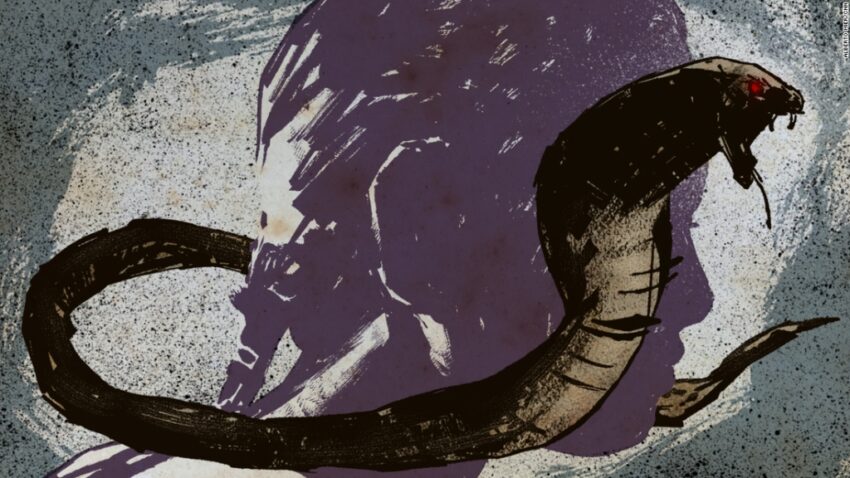She died from a snakebite. But the real killer was her husband

Her family rushed her to the local Kollam hospital in the southern Indian state of Kerala, but the 25-year-old was already dead. A post-mortem on May 7, 2020, confirmed she’d been bitten hours earlier by a highly venomous Indian spectacled cobra, according to court documents.In India, where snake bites are not uncommon, that could have been the end of it. But her family grew suspicious and filed a complaint with police.After a trial that made national headlines, Uthra’s killer was found guilty and sentenced to life in prison for crimes the sentencing judge called “diabolic and ghastly.”The judge found Uthra’s death was caused by the cobra — but the real killer was her husband.And it wasn’t the first time he’d used a snake as a weapon.A broken love storySuraj Kumar and Uthra, who went only by her first name, met through a matchmaking service and married in March 2018. “We wanted to find someone who would make her happy,” said Uthra’s brother, Vishu, who also only uses one name. “She was a girl who was a little different. She had a learning disability. We wanted a man who could take care of her.”Kumar, a 27-year-old bank clerk, did not come from a financially stable background. His father was an auto-rickshaw driver, and his mother, a housewife.According to the judgment, Kumar married Uthra “with the object of financial gain.”When the couple married, Kumar accepted a dowry of 720 grams of gold, a Suzuki sedan and 500,000 rupees (about $6,700) in cash.
“Uthra was someone who never saw bad in anyone”VishuUthra’s brother
The first few months of married life seemed “uneventful” and within a year they had a son, the judgment said. But it wasn’t long before Kumar’s parents wanted more.According to the judgment, Kumar’s parents demanded Uthra’s parents pay for household appliances, a car, furniture, renovation work, and admission fees for an MBA course for Kumar’s sister.”Uthra was someone who never saw bad in anyone,” Vishu said. “Her learning disability meant she didn’t have the means to see that she was being used.” Uthra’s father told the court he met all of Kumar’s demands and also paid him 8,000 rupees ($107) per month to take care of his daughter.But Kumar grew “dissatisfied” with Uthra’s learning disability, according to the judgment. He began to plot her death.Failed murder attemptIn late 2019, Kumar appeared to develop an obsession with snakes. He spent hours on the internet, watching YouTube videos, including episodes of “Snake Master,” featuring renowned snake expert Vava Suresh. Suresh’s YouTube channel, which has more than 270,000 subscribers, shows him calmly interacting with snakes, including the highly potent Russell’s viper, one of the most aggressive snakes in Asia. Uthra woke up screaming in “excruciating pain,” and with some delay she was taken to the hospital by Kumar, who claimed she had been bitten outside at night while washing clothes.Uthra contradicted his version of events by saying she never did the washing after dusk. The very next day, as his wife lay in hospital, Kumar was back on his phone researching snakes — but this time he searched for “cobra.” The murderUthra spent 52 days in Pushpagiri Hospital in the Kerala town of Thiruvalla recovering from the viper bite, and when she was finally released to her parent’s care on April 22 last year, she was unable to walk. As she lay in bed, her leg bandaged after skin grafts, Kumar decided to strike.On May 6, just 15 days after she had left hospital, he smuggled another snake he’d bought from snake handler Chavarukavu Suresh into her parent’s house. This time it was a cobra.Before going to bed, Kumar gave Uthra a glass of juice laced with sedatives, according to the judgment. As she slept, Kumar threw the serpent at her, but the reptile didn’t bite, so he grabbed its head and forced its fangs deep into her left arm — twice. Despite his efforts to make it appear as an accident, a number of clues suggested the bites weren’t natural — from the width of the fang marks, to the position of the bites, and the impossibility that the cobra had entered the room on its own.
“Cobras generally do not bite unless they are highly provoked. And after 8 p.m. they’re generally dormant”Hari ShankarKerala Police
The two pairs of bite marks on Uthra’s arm had a width of 2.3 and 2.8 centimeters (0.9 and 1.1 inches) respectively, much larger than the typical width of cobra fangs of between 0.4 to 1.6 centimeters (0.16 to 0.63 inches), experts told the court. That indicated the cobra’s upper jaw had been pushed as if it was being milked. The time of day also raised suspicion.”Cobras generally do not bite unless they are highly provoked. And after 8 p.m. they’re generally dormant,” said Hari Shankar, an assistant inspector general at Kerala Police, who worked as lead investigator on the case. In court, investigators demonstrated their argument by setting up an experiment to demonstrate whether a cobra would strike a sleeping person. In the video, the same type of cobra was thrown on a bed with a mannequin at night. The video shows the snake slithering away several times and only biting into a chicken breast tied to a limb when repeatedly provoked.span{color:#C5C5C5;}
]]>
Investigators threw another cobra on a mannequin to see how it would react.Experts also raised doubts over how the cobra came to be in Uthra’s room. Cobras can only raise themselves vertically to one-third of their length, the court was told, meaning the 152-centimeter (60-inch) cobra that bit Uthra could only have raised itself to a height of around 50 centimeters — not high enough to enter through the windows. Three air holes in the room were also sealed.And lastly, Uthra had slept through what was arguably one of the most painful experiences of her life.Vava Suresh, the star snake catcher Kumar had watched online, was called to give evidence. He told the court that during his 30-year career he had been bitten 16 times by a Russell’s viper and 340 times by cobra, resulting in “excruciating” and “severe” pain — though only three viper bites and 10 cobra bites were “critical,” he said.The snake catcher said he had to amputate his left middle finger after a cobra bite, and after another bite can no longer fully rotate his right wrist. He said a snake that bites for self-protection would not strike twice, as the animals spare their venom. And he was sure Uthra would have woken on being bitten — if she hadn’t been sedated.Kumar stayed awake all night after the attack, the judgment said, during which he destroyed the evidence by washing the glass tumbler and the stick used to handle the snake.He also deleted his call history, which proved he had been in contact with the snake handler, according to the judgment.After Uthra was pronounced dead, her brother Vishu found the cobra inside the family home and killed it. He followed police advice to bury the serpent at the house and marked the location with a stick. During the investigation, the snake’s carcass was dug up, and a post-mortem examination showed its abdomen was empty — a “very significant” development, according to the investigator, Shankar.”Generally, a snake takes seven days to digest food,” he said. “Which means it had been at least seven days since it had eaten something. A cobra which lives in a natural habitat eats at least twice in a day. “So that means the snake that bit Uthra had been kept in confinement.”span{color:#C5C5C5;}
]]>
The cobra used in the video experiment only lashed out when repeatedly provoked.Death by snakebiteUthra’s death is not the first in India involving an accusation of murder by snake.India’s Supreme Court denied bail to Krishna Kumar on October 6, one of three people accused of murder in the death of a woman from the northern state of Rajasthan by leaving a venomous snake in a bag near her bed, according to local news outlet NDTV.People buying venomous snakes from snake charmers to kill others by snakebite is “a new trend” that is “becoming common in Rajasthan,” said Justice Surya Kant during the bail hearing, NDTV reported.Snakebite deaths are not rare in India, with 1.2 million such fatalities from 2000 to 2019, according to the World Health Organization.But Shankar, the investigator, said 99.9% of snakebites in India are characterized as “accidental.” “We do not know (how many) of those cases could have been murders, but passed off as an accident,” he said. “(In such cases), it’s very important to prove that the bite is homicidal. We proved that the person was drugged and recovered the container from the accused, proved that he bought the snake, his mobile search patterns, all those things.” ‘This is shocking to us’On May 8 — the day after Uthra’s death — Chavarukavu Suresh, the snake handler who sold Kumar the cobra read about her death in the local newspaper. He tried to phone Kumar, the court heard, but Kumar didn’t answer. The next day, Kumar returned Suresh’s call and told him he mustn’t tell anyone that he’d sold him the snake.Suresh said he asked Kumar why he’d committed a “grave sin,” and Kumar responded that he couldn’t live with his wife anymore. If Suresh remained silent, he said, they could pass her death off as a “serpent curse” and both avoid being implicated in murder. In Kerala, a “serpent curse” is a superstitious belief that cobras have the power to curse families who don’t worship them. But when police arrested Kumar, they also arrested Chavarukavu Suresh, who confessed to selling him both snakes, though Suresh insisted he had nothing to do with plotting the murder. He was pardoned by Kollam’s Chief Judicial Magistrate, leaving Kumar as the prime suspect. Chavarukavu Suresh later testified against Kumar in court.
“Despite being the rarest of rare cases, they were able to prove his guilt”VishuUthra’s brother
The prosecution called multiple experts who testified the Russell’s viper bite was also unnatural. The experts said it was all but impossible for the ground-dwelling snake to navigate the smooth tiles to the first floor of Kumar’s home, where Uthra was bitten. Furthermore, the bite marks were vertical, suggesting she had been bitten while lying down. Snake expert Vava Suresh told the court Russell’s vipers like dry, arid landscapes, whereas Kumar’s home was built on marshy land. He also said locals had told him they hadn’t seen a Russell’s viper in the area for 15 years.Kumar pleaded not guilty to the charges, but the judge convicted him of four offenses, including attempted murder and murder, and he was given two life sentences.Five weeks after Kumar’s conviction, her family is still in disbelief that the man they trusted to love their daughter had plotted to kill her.”Police and the prosecution have done their work well,” her brother Vishu said. “Despite being the rarest of rare cases, they were able to prove his guilt. “But (Kumar) was stoic and showed no remorse. That is shocking to us.” Their focus now is to ensure that Uthra’s 2-year-old son grows up happy and remembers his mother for the loving and caring woman she was. Whenever Uthra’s family shows her son a photograph of his mother, he smiles, Vishu said. “He will throw his hand up to the photo and say ‘Uthra amma, Uthra amma,'” using the Malayalam word for mother, he said. “We will make sure he knows who his mother was.”







